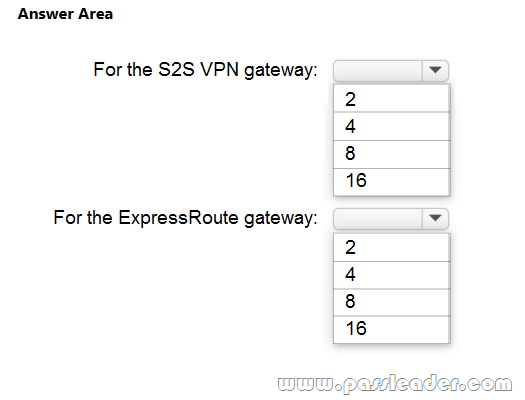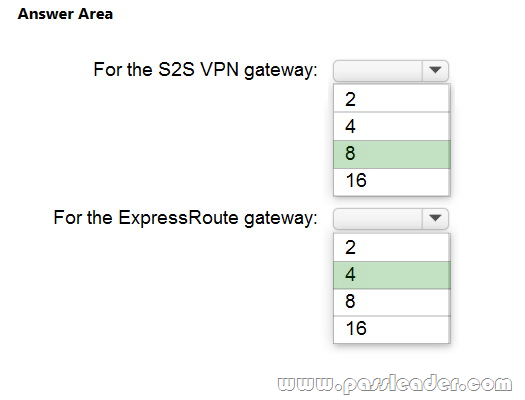Valid AZ-700 Dumps shared by PassLeader for Helping Passing AZ-700 Exam! PassLeader now offer the newest AZ-700 VCE dumps and AZ-700 PDF dumps, the PassLeader AZ-700 exam questions have been updated and ANSWERS have been corrected, get the newest PassLeader AZ-700 dumps with VCE and PDF here: https://www.passleader.com/az-700.html (276 Q&As Dumps)
BTW, DOWNLOAD part of PassLeader AZ-700 dumps from Cloud Storage: https://drive.google.com/drive/folders/11GBu3Jq_EWsF2NUi__ZcspE_oTcAzPym
NEW QUESTION 221
You have three on-premises networks. You have an Azure subscription that contains a Basic Azure virtual WAN. The virtual WAN contains a single virtual hub and a virtual network gateway that is limited to a throughput of 1 Gbps. The on-premises networks connect to the virtual WAN by using Site-to-Site (S2S) VPN connections. You need to increase the throughput of the virtual WAN to 3 Gbps. The solution must minimize administrative effort. What should you do?
A. Upgrade the virtual WAN to the Standard SKU.
B. Add an additional VPN gateway to the Azure subscription.
C. Create an additional virtual hub.
D. Increase the number of gateway scale units.
Answer: D
Explanation:
https://learn.microsoft.com/en-us/azure/virtual-wan/gateway-settings#s2s
NEW QUESTION 222
You have 10 on-premises networks that are connected by using a 3rd party Software Defined Wide Area Network (SD-WAN) solution. You have an Azure subscription that contains five virtual networks. You plan to connect the Azure virtual networks and the on-premises networks by using an Azure Virtual WAN with a single virtual WAN hub. You need to ensure that the Azure Virtual WAN can act as a node in the 3rd party SD-WAN solution. What should you include in the solution?
A. An Azure Virtual WAN ExpressRoute gateway.
B. A Network Virtual Appliance (NVA).
C. A Site to site gateway (VPN gateway).
D. A Point to site gateway (User VPN gateway).
Answer: B
Explanation:
https://learn.microsoft.com/en-us/azure/virtual-wan/sd-wan-connectivity-architecture#direct-nva
NEW QUESTION 223
You have an Azure subscription that contains a virtual network named VNet1. You deploy several web apps and configure the apps to use private endpoints on VNet1. You need to identify which DNS records the web apps registered automatically. Where will the records be created?
A. an Azure DNS zone named privatelink.azurewebsites.net
B. an Azure Private DNS zone named azurewebsites.net
C. an Azure Private DNS zone named privatelink.azurewebsites.net
D. an Azure DNS zone named azurewebsites.net
Answer: C
Explanation:
On creating a private endpoint in portal: your private endpoint will be integrated with the private DNS zone ‘privatelink.azurewebsites.net’ in the resource group of the selected subnet. If the private DNS zone does not exist, it will be created automatically.
NEW QUESTION 224
You are planning the IP addressing for the subnets in Azure virtual networks. Which type of resource requires IP addresses in the subnets?
A. storage account
B. internal load balancers
C. service endpoints
D. service endpoint policies
Answer: B
NEW QUESTION 225
You plan to implement an Azure virtual network that will contain 10 virtual subnets. The subnets will use IPv6 addresses. Each subnet will host up to 200 load-balanced virtual machines. You need to recommend which subnet mask size to use for the virtual subnets. What should you recommend?
A. /64
B. /120
C. /48
D. /24
Answer: A
Explanation:
The subnets for IPv6 must be exactly /64 in size. This ensures future compatibility should you decide to enable routing of the subnet to an on-premises network since some routers can only accept /64 IPv6 routes.
https://learn.microsoft.com/en-us/azure/virtual-network/ip-services/ipv6-overview#capabilities
NEW QUESTION 226
You have an Azure subscription that contains a virtual network named VNet1. VNet1 contains a subnet named Subnet1. You deploy an instance of Azure Application Gateway v2 named AppGw1 to Subnet1. You create a network security group (NSG) named NSG1 and link NSG1 to Subnet1. You need to ensure that AppGw1 will only load balance traffic that originates from VNet1. The solution must minimize the impact on the functionality of AppGw1. What should you add to NSG1?
A. an outbound rule that has a priority of 4096 and blocks all internet traffic
B. an inbound rule that has a priority of 4096 and blocks all internet traffic
C. an inbound rule that has a priority of 100 and blocks all internet traffic
D. an outbound rule that has a priority 100 and blocks all internet traffic
Answer: B
NEW QUESTION 227
You plan to implement an Azure virtual network that will contain 10 virtual subnets. The subnets will use IPv6 addresses. Each subnet will host up to 200 load-balanced virtual machines. You need to recommend a load balancing solution for the virtual network. The solution must meet the following requirements:
– The virtual machines and the load balancer must be accessible only from the virtual network.
– Costs must be minimized.
What should you include in the recommendation?
A. Basic Azure Load Balancer
B. Azure Application Gateway v1
C. Azure Standard Load Balancer
D. Azure Application Gateway v2
Answer: C
NEW QUESTION 228
You have an Azure subscription that contains the following resources:
– A virtual network named Vnet1.
– Two subnets named subnet1 and AzureFirewallSubnet.
– A public Azure Firewall named FW1.
– A route table named RT1 that is associated to Subnet1.
– A rule routing of 0.0.0.0/0 to FW1 in RT1.
After deploying 10 servers that run Windows Server to Subnet1, you discover that none of the virtual machines were activated. You need to ensure that the virtual machines can be activated. What should you do?
A. On FW1, configure a DNAT rule for port 1688.
B. Deploy an application security group that allows outbound traffic to 1688.
C. Add an internet route to RT1 for the Azure Key Management Service (KMS).
D. Deploy an Azure Standard Load Balancer that has an outbound NAT rule.
Answer: C
NEW QUESTION 229
You have an Azure subscription that contains the following resources:
– A virtual network named Vnet1.
– Two subnets named subnet1 and AzureFirewallSubnet.
– A public Azure Firewall named FW1.
– A route table named RT1 that is associated to Subnet1.
– A rule routing of 0.0.0.0/0 to FW1 in RT1.
After deploying 10 servers that run Windows Server to Subnet1, you discover that none of the virtual machines were activated. You need to ensure that the virtual machines can be activated. What should you do?
A. On FW1, create an outbound service tag rule for AzureCloud.
B. Deploy an Azure Standard Load Balancer that has an outbound NAT rule.
C. On FW1, create an outbound network rule that allows traffic to the Azure Key Management Service (KMS).
D. To Subnet1, associate a network security group (NSG) that allows outbound access to port 1688.
Answer: C
NEW QUESTION 230
You have an Azure Private Link service named PL1 that uses an Azure load balancer named LB1. You need to ensure that PL1 can support a higher volume of outbound traffic. What should you do?
A. Increase the number of frontend IP configurations for LB1.
B. Increase the number of NAT IP addresses assigned to PL1.
C. Deploy an Azure Application Gateway v2 instance to the source NAT subnet.
D. Redeploy LB1 with a different SKU.
Answer: B
Explanation:
https://learn.microsoft.com/en-us/azure/private-link/private-link-service-overview
NEW QUESTION 231
You have the Azure virtual networks shown in the following table:

You deploy Azure Firewall to Vnet3. You need to ensure that the traffic from Subnet1-1 to Subnet2-1 passes through the firewall. What should you configure?
A. peering links between Vnet1 and Vnet2
B. a route table associated to Subnet1-1 and Subnet2-1
C. an Azure private DNS zone
D. a route table associated to AzureFirewallSubnet
Answer: B
Explanation:
https://learn.microsoft.com/en-us/azure/firewall/tutorial-firewall-deploy-portal#create-a-default-route
NEW QUESTION 232
HotSpot
You have an Azure subscription. You plan to use Azure Virtual WAN. You need to deploy a virtual WAN hub that meets the following requirements:
– Supports 4 Gbps of Site-to-Site (S2S) VPN traffic.
– Supports 8 Gbps of ExpressRoute traffic.
– Minimizes costs.
How many scale units should you configure? (To answer, select the appropriate options in the answer area.)

Answer:

Explanation:
– For S2S 1 scale unit = 500 Mbps
4000/500 = 8 scale units
https://learn.microsoft.com/en-us/azure/virtual-wan/gateway-settings#s2s
– For ExpressRoute 1 scale unit = 2Gbps
8/2 = 4
https://learn.microsoft.com/en-us/azure/virtual-wan/virtual-wan-expressroute-about#expressroute-performance
NEW QUESTION 233
HotSpot
You have an Azure subscription that contain a storage account named st1 in the East US Azure region. You have the virtual networks shown in the following table:

You have the subnets shown in the following table:

For each of the following statements, select Yes if the statement is true. Otherwise, select No.

Answer:

Explanation:
Box 1: No. Azure Bastion requires a dedicated subnet: AzureBastionSubnet. You must create this subnet in the same virtual network that you want to deploy Azure Bastion to. The subnet must have the following configuration:
– Subnet name must be AzureBastionSubnet.
– Subnet size must be /26 or larger.
https://learn.microsoft.com/en-us/azure/bastion/configuration-settings#subnet
Box 2: Yes. With /25 we have more than 100 IP’s left to use. Should not be a problem to deploy 100 additional VM’s with a single IP.
Box 3: No. You can not change the IP address range of subnet3-1 range to 10.3.1.0/16. Azure will give this error ‘10.3.1.0/16 is not a valid CIDR block’ because its higher than the Vnet’s IP address space of 10.3.0.0/16.
NEW QUESTION 234
Drag and Drop
You have two on-premises datacenters. You have an Azure subscription that contains four virtual networks named VNet1, VNet2, VNet3, and VNet4. You create an Azure virtual WAN named VWAN1. VWAN1 contains a single virtual hub that is connected to both on-premises datacenters and all the virtual networks in a full mesh topology. You create a route table named RT1. You need to configure VWAN1 to meet the following requirements:
– Connectivity between VNet1 and VNet2 and both on-premises datacenters must be allowed.
– Connectivity between VNet3 and VNet4 and both on-premises datacenters must be allowed.
– VNet1 and VNet2 must be isolated from VNet3 and VNet4.
How should you configure routing for VNet1 and VNet2 and for both on-premises datacenters? (To answer, drag the appropriate route tables and route table propagation to the correct requirements. Each route table and route table propagation may be used once, more than once, or not at all. You may need to drag the split bar between panes or scroll to view content.)

NEW QUESTION 235
Drag and Drop
You have an on-premises network. You have an Azure subscription that contains a virtual network named VNet1. VNet1 contains an ExpressRoute gateway. You need to connect VNet1 to the on-premises network by using an ExpressRoute circuit. Which four actions should you perform in sequence? (To answer, move the appropriate actions from the list of actions to the answer area and arrange them in the correct order.)

Answer:

Explanation:
1. Create the ExpressRoute circuit.
https://learn.microsoft.com/en-us/azure/expressroute/expressroute-howto-circuit-portal-resource-manager#create-a-new-expressroute-circuit
2. Send a service key to your connectivity provider.
https://learn.microsoft.com/en-us/azure/expressroute/expressroute-howto-circuit-portal-resource-manager#send-the-service-key-to-your-connectivity-provider-for-provisioning
3. Configure Azure private peering.
https://learn.microsoft.com/en-us/azure/expressroute/expressroute-howto-routing-portal-resource-manager#to-create-azure-private-peering
4. Create a connection from Vnet1 to the ExpressRoute circuit.
https://learn.microsoft.com/en-us/azure/expressroute/expressroute-howto-linkvnet-portal-resource-manager#prerequisites
NEW QUESTION 236
……
Get the newest PassLeader AZ-700 VCE dumps here: https://www.passleader.com/az-700.html (276 Q&As Dumps)
And, DOWNLOAD the newest PassLeader AZ-700 PDF dumps from Cloud Storage for free: https://drive.google.com/drive/folders/11GBu3Jq_EWsF2NUi__ZcspE_oTcAzPym
